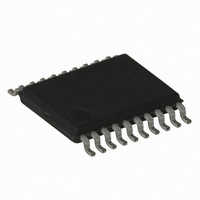ATTINY167-15XD Atmel, ATTINY167-15XD Datasheet - Page 33

ATTINY167-15XD
Manufacturer Part Number
ATTINY167-15XD
Description
MCU AVR 16K FLASH 15MHZ 20-TSSOP
Manufacturer
Atmel
Series
AVR® ATtinyr
Datasheet
1.ATTINY167-15MD.pdf
(283 pages)
Specifications of ATTINY167-15XD
Core Processor
AVR
Core Size
8-Bit
Speed
16MHz
Connectivity
I²C, LIN, SPI, UART/USART, USI
Peripherals
Brown-out Detect/Reset, POR, PWM, Temp Sensor, WDT
Number Of I /o
16
Program Memory Size
16KB (8K x 16)
Program Memory Type
FLASH
Eeprom Size
512 x 8
Ram Size
512 x 8
Voltage - Supply (vcc/vdd)
2.7 V ~ 5.5 V
Data Converters
A/D 11x10b
Oscillator Type
Internal
Operating Temperature
-40°C ~ 150°C
Package / Case
20-TSSOP
Processor Series
ATTINY1x
Core
AVR8
Data Bus Width
8 bit
Data Ram Size
512 B
Maximum Clock Frequency
16 MHz
Maximum Operating Temperature
+ 85 C
Mounting Style
SMD/SMT
3rd Party Development Tools
EWAVR, EWAVR-BL
Development Tools By Supplier
ATAVRDRAGON, ATSTK500, ATSTK600, ATAVRISP2, ATAVRONEKIT
Minimum Operating Temperature
- 40 C
For Use With
ATSTK600-SOIC - STK600 SOCKET/ADAPTER FOR SOIC
Lead Free Status / RoHS Status
Lead free / RoHS Compliant
- Current page: 33 of 283
- Download datasheet (5Mb)
4.3.4
4.3.5
4.3.6
4.3.7
7728G–AVR–06/10
COUT Command
Clock Availability
System Clock Source Recovering
Clock Switching
Clock Source’ command. This will indicate via the CLKRDY bit in the CLKCSR register that a
valid clock source is available and operational.
The ‘Disable Clock Source’ command disables the clock source indicated by the settings of
CLKSELR register (only CSEL3..0). If the clock source indicated is currently the one that is
used to drive the system clock, the command is not executed.
Because the selected configuration is latched at clock source level, it is possible to enable
many clock sources at a given time (ex: the internal RC oscillator for system clock + an oscilla-
tor with external crystal). The user (code) is responsible of this management.
The ‘CKOUT ’ command allows to drive the CLKO pin. Refer to
Buffer” on page 31
‘Request for Clock Availability’ command enables a hardware oscillation cycle counter driven
by the selected source clock, CSEL3..0. The count limit value is determined by the settings of
CSUT1..0. The clock is declared ready (CLKRDY = 1) when the count limit value is reached.
The CLKRDY flag is reset when the count starts. Once set, this flag remains unchanged until a
new count is commanded. To perform this checking, the CKSEL and CSUT fields should not
be changed while the operation is running.
Note that once the new clock source is selected (‘Enable Clock Source’ command), the count
procedure is automatically started. The user (code) should wait for the setting of the CLKRDY
flag in CLKSCR register before using a newly selected clock.
At any time, the user (code) can ask for the availability of a clock source. The user (code) can
request it by writing the ‘Request for Clock Availability ’ command in the CLKSCR register. A
full polling of the status of clock sources can thus be done.
The ‘Recover System Clock Source’ command returns the current clock source used to drive
the system clock as per
updated with this returned value. There is no information on the SUT used or status on
CKOUT.
To drive the system clock, the user can switch from the current clock source to any other of the
following ones (one of them being the current clock source):
The clock switching is performed by a sequence of commands. First, the user (code) must
make sure that the new clock source is operating. Then the ‘Clock Source Switching’ com-
mand can be issued. Once this command has been successfully completed using the
‘Recover System Clock Source’ command, the user (code) may stop the previous clock
source.
1. Calibrated internal RC oscillator 8.0 MHz,
2. Internal watchdog oscillator 128 kHz,
3. External clock,
4. External low-frequency oscillator,
5. External Crystal/Ceramic Resonator.
for using.
Table 4-1 on page
25. The CKSEL field of CLKSELR register is then
ATtiny87/ATtiny167
Section 4.2.7 “Clock Output
33
Related parts for ATTINY167-15XD
Image
Part Number
Description
Manufacturer
Datasheet
Request
R

Part Number:
Description:
Manufacturer:
Atmel Corporation
Datasheet:

Part Number:
Description:
Manufacturer:
Atmel Corporation
Datasheet:

Part Number:
Description:
MCU AVR 16K FLASH 15MHZ 32-QFN
Manufacturer:
Atmel
Datasheet:

Part Number:
Description:
IC MCU AVR 16K FLASH 20TSSOP
Manufacturer:
Atmel
Datasheet:

Part Number:
Description:
MCU AVR 16K FLASH 15MHZ 32-QFN
Manufacturer:
Atmel
Datasheet:

Part Number:
Description:
MCU AVR 16K FLASH 15MHZ 20-SOIC
Manufacturer:
Atmel
Datasheet:

Part Number:
Description:
MCU AVR 16K FLASH 15MHZ 20-TSSOP
Manufacturer:
Atmel
Datasheet:

Part Number:
Description:
IC MCU AVR 16K FLASH 20SOIC
Manufacturer:
Atmel
Datasheet:










